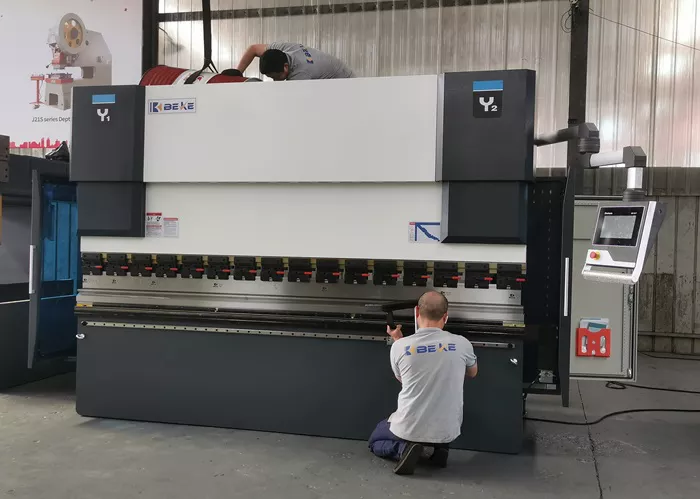A press brake is a machine used in metalworking to bend and shape metal sheets and plates. It is a versatile tool that plays a crucial role in various industries, including manufacturing, construction, and automotive. Press brakes are commonly used for bending metal into precise angles, forming intricate shapes, and creating complex parts for machinery and structures.
The machine operates by using a punch and die system to apply force to a workpiece. The punch, attached to the ram, moves downwards, while the die remains stationary at the bottom of the machine. The metal sheet is placed between the punch and the die, and the press brake applies force to bend or shape the metal as desired.
How Does a Press Brake Work?
The working principle of a press brake is based on applying a compressive force to a metal sheet. This force is generated by a hydraulic or mechanical system, which drives the ram that holds the punch. The punch applies pressure to the metal sheet placed over the die, causing it to bend. The degree of bend depends on various factors, including the thickness of the sheet, the material properties, and the die shape.
Types of Press Brakes
Press brakes come in several types, each offering specific benefits for different applications. The primary types include:
- Mechanical Press Brakes: These are powered by a flywheel and a clutch system. They are more economical but are limited in terms of bending capacity and precision.
- Hydraulic Press Brakes: These machines use hydraulic cylinders to provide consistent and adjustable force. They are more versatile and offer greater precision and control over the bending process.
- Electric Press Brakes: These are powered by electric motors and are more energy-efficient than hydraulic models. They are ideal for smaller operations or environments where energy efficiency is crucial.
- Pneumatic Press Brakes: These machines use compressed air to apply force. They are typically used for lighter operations and less complex bending tasks.
Applications of Press Brakes
Press brakes are employed in a wide range of industries for various applications. Some common uses include:
- Sheet Metal Bending: Press brakes are ideal for bending sheet metal into a wide range of shapes, such as angles, curves, and boxes.
- Automotive Industry: In automotive manufacturing, press brakes are used to form complex body panels and other metal components.
- Construction: Press brakes are employed in construction to create metal frames, beams, and supports.
- Aerospace: Press brakes are used to create intricate parts for aircraft and spacecraft, requiring high precision and quality control.
Advantages of Using a Press Brake
Press brakes offer numerous benefits that make them an essential tool in metalworking operations:
- Precision: Press brakes allow for high levels of accuracy in bending metal, ensuring consistent and reliable results.
- Versatility: With different punch and die combinations, press brakes can be used to bend a wide range of materials and thicknesses.
- Efficiency: Modern press brakes can process metal sheets quickly, improving production speeds and reducing labor costs.
- Automation: Many press brakes are equipped with advanced CNC (Computer Numerical Control) systems, which enable automatic adjustments for different bending tasks.
Challenges in Press Brake Operations
While press brakes are highly useful, they also come with certain challenges:
- Material Limitation: Some materials, such as high-strength alloys, may require specialized tooling or modifications to the press brake for effective bending.
- Operator Skill: To achieve optimal results, operators must have adequate training to understand the machine’s settings and how to apply the right amount of force.
- Maintenance: Regular maintenance is necessary to keep press brakes in good working condition. Lack of proper upkeep can lead to machine failure or reduced performance.
How to Choose the Right Press Brake for Your Needs
Choosing the right press brake depends on several factors, including the type of material being worked on, the desired bending accuracy, and the production volume. When selecting a press brake, consider the following:
- Bending Capacity: Ensure the machine has the capacity to handle the material thickness and size you intend to work with.
- Control System: Decide between a manual, hydraulic, or CNC-controlled press brake depending on your precision requirements and level of automation.
- Die Options: The type of die used can affect the bend quality. Choose a press brake that supports the right die for your needs.
- Brand and Reliability: Invest in a reputable brand known for producing durable and reliable machines.
Conclusion
In conclusion, a press brake is an essential machine for shaping and bending metal materials in various industries. By understanding its operation, types, applications, and advantages, you can make informed decisions about using a press brake in your manufacturing processes. With technological advancements and increased automation, press brakes continue to evolve, offering greater precision and efficiency for metalworking tasks.

